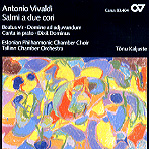What better combination of performers could you ask for than the Estonian Philharmonic Chamber Choir, Tallinn Chamber Orchestra, and conductor Tõnu Kaljuste, for just about anything involving voices and instruments, from early music to newly composed works? Well, in the case of this recording, you could ask for more compelling, involving, stimulating–heck, why don’t we just say it–less boring repertoire. While Vivaldi wrote some terrific instrumental works–the Op. 3, Op. 8, and Op. 11 concerti grossi, various solo-instrument concertos–his choral pieces lack the distinctive qualities of a truly vocal idiom. In other words, they just seem like instrumental works with words plugged in. An exception here may be the lovely, rich-textured “Exortum est in tenebris” (in the Beatus vir) that briefly impresses with its full-bodied, voice-friendly choral sound, or the expressive alto/tenor/bass trio “In memoria aeterna”; but in keeping with Vivaldian tradition, for the most part you could substitute almost any combination of instruments for the singers and the result would be just as satisfying.
The soloists are generally fine, except that soprano Kaia Urb proves fatally infected with the “huh-huh-huh-huh-huh” virus in her fast melismatic passages in Beatus vir’s “Gloria et divitiae”. Somehow she sheds that affliction in her later solos. Sonically, the recording is uneven in spite of the fact that it was produced from one venue, presumably in several sessions. As one example, the double-chorus “Paratum cor ejus” section of the Beatus vir sounds as if it were recorded in an acoustic different from all that came before–distant, extremely resonant, and slightly thin of body.
The orchestra is fabulous, showing its virtuosity throughout, and proving absolutely top notch as an accompanist in its turn-on-a-dime responsiveness to Kaljuste’s super-charged conducting (listen to the electrifying opening of Domine ad adjuvandum me festina, for example, or the rousing “Sicut erat in principio” movement that concludes the piece). And this chorus, one of the world’s premier ensembles, typically delivers faultless performances, precise, spirited, fully committed–which almost makes us forget the often uninspiring music.
In spite of my less than complimentary assessment of Vivaldi’s command of vocal composition, I was unequivocally impressed by the Canta in prato RV 636. Again, this solo motet (sung here by a soprano) could just as well be performed on violin, cello, flute, bassoon, guitar–you name it. But it’s brimming with infectious energy and catchy melodies and the performance here is outstanding. The following Dixit Dominus–the most familiar of the works included on the program–is perfectly acceptable but is somewhat sabotaged by over-resonant, edgy sound. My satisfaction level with this recording kept fluctuating–from movement to movement. There’s some really fine–and really dull–music here. But the performances are worth hearing, especially if you’re seriously interested in exploring this exactly-the-same-yet-different corner of Vivaldi’s multi-faceted output.
































